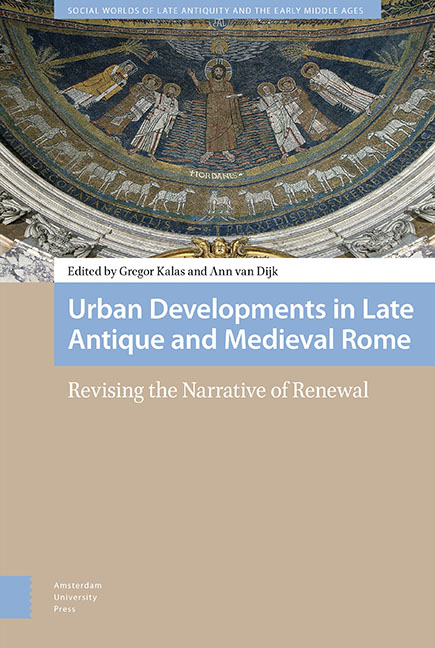Book contents
- Frontmatter
- Contents
- Preface and Acknowledgments
- List of Abbreviations
- 1 Introduction: Revising the Narrative of Renewal for Late Antique and Medieval Rome
- 2 Rome at War: The Effects of Crisis on Church and Community in Late Antiquity
- 3 Portraits of Poets and the Lecture Halls in the Forum of Trajan : Masking Cultural Tensions in Late Antique Rome
- 4 Rolling Out the Red Carpet, Roman-Style : The Arrival at Rome From Constantine to Charlemagne
- 5 (Re-)Founding Christian Rome: The Honorian Project of the Early Seventh Century
- 6 After Antiquity: Renewing the Past or Celebrating the Present? Early Medieval Apse Mosaics in Rome
- 7 The Re-Invention of Rome in the Early Middle Ages
- 8 Rewriting the Renouveau
- 9 Renewal, Heritage, and Exchange in Eleventh-Century Roman Chant Traditions
- 10 Reforming Readers, Reforming Texts: The Making of Discursive Community in Gregorian Rome
- Manuscripts Cited
- Index
8 - Rewriting the Renouveau
Published online by Cambridge University Press: 18 June 2021
- Frontmatter
- Contents
- Preface and Acknowledgments
- List of Abbreviations
- 1 Introduction: Revising the Narrative of Renewal for Late Antique and Medieval Rome
- 2 Rome at War: The Effects of Crisis on Church and Community in Late Antiquity
- 3 Portraits of Poets and the Lecture Halls in the Forum of Trajan : Masking Cultural Tensions in Late Antique Rome
- 4 Rolling Out the Red Carpet, Roman-Style : The Arrival at Rome From Constantine to Charlemagne
- 5 (Re-)Founding Christian Rome: The Honorian Project of the Early Seventh Century
- 6 After Antiquity: Renewing the Past or Celebrating the Present? Early Medieval Apse Mosaics in Rome
- 7 The Re-Invention of Rome in the Early Middle Ages
- 8 Rewriting the Renouveau
- 9 Renewal, Heritage, and Exchange in Eleventh-Century Roman Chant Traditions
- 10 Reforming Readers, Reforming Texts: The Making of Discursive Community in Gregorian Rome
- Manuscripts Cited
- Index
Summary
Abstract
The art and architecture of eleventh-century Rome are predominantly discussed within the framework of an ‘early Christian renewal’ (renouveau paléochrétien) closely tied to the Gregorian Reform. Articulated fifty years ago in accordance with the prevailing top-down model of history, the framework is incompatible with more recent historical approaches that emphasize agency from below. This essay argues for a more distributed model of agency in the making of eleventh-century art. A case study of Santa Maria in Trastevere, reformed in 1065, calls into question the model of a Reform art directed by cardinals. A comparison with cinematic auteur theory questions the concept of a Reformist ‘directed art’ from another perspective.
Keywords: Gregorian Reform, portal sculpture, Giant Bibles, San Clemente, Santa Maria in Trastevere, auteur theory
In one of the most influential contributions to the study of medieval Roman art of the past century, Hélène Toubert made the case that Roman wall paintings and mosaics of the later eleventh and twelfth centuries constituted a renouveau paléochrétien inspired by Montecassino and the institutional Reform associated with Pope Gregory VII (1073–1085). Her argument was endorsed by Richard Krautheimer in his equally influential monograph of 1980, in a chapter titled ‘The New Rebirth of Rome’. Krautheimer's purview was broader than Toubert’s, encompassing architecture, marble ornament, and salvaged antiquities in addition to painting, and he posited a wider context, integrating the revival of early Christian forms and motifs into an overall revival of antiquity. According to Krautheimer, the revival arose from a ‘matrix’ of Petrine, Constantinian, and imperial traditions, ‘pregnant with political implications.’ Krautheimer's emphasis on politically charged renovatio was echoed by Peter Cornelius Claussen, who refined the approach by distinguishing three phases: a phase of repair and consolidation (restauratio) before 1100, heavily dependent on Montecassino; a wave of renewal (renovatio) under Pope Paschal II (1099–1118), which achieved the fullest material expression of the Gregorian Reform; and a triumphal phase (renovatio triumphans) after the conclusion of the Investiture Controversy in 1122, in which Constantinian and Petrine models were emulated to signal the quasi-imperial stature of the popes. Claussen argued that the turn to the past was fueled less by the fragments of Roman antiquity visible everywhere in the medieval city than by an ideal image of ancient splendor. In the medieval imaginary, ancient Rome was an ‘aesthetic utopia’ marked by shiny, colorful surfaces of marble and gold.
- Type
- Chapter
- Information
- Urban Developments in Late Antique and Medieval RomeRevising the Narrative of Renewal, pp. 237 - 278Publisher: Amsterdam University PressPrint publication year: 2021



